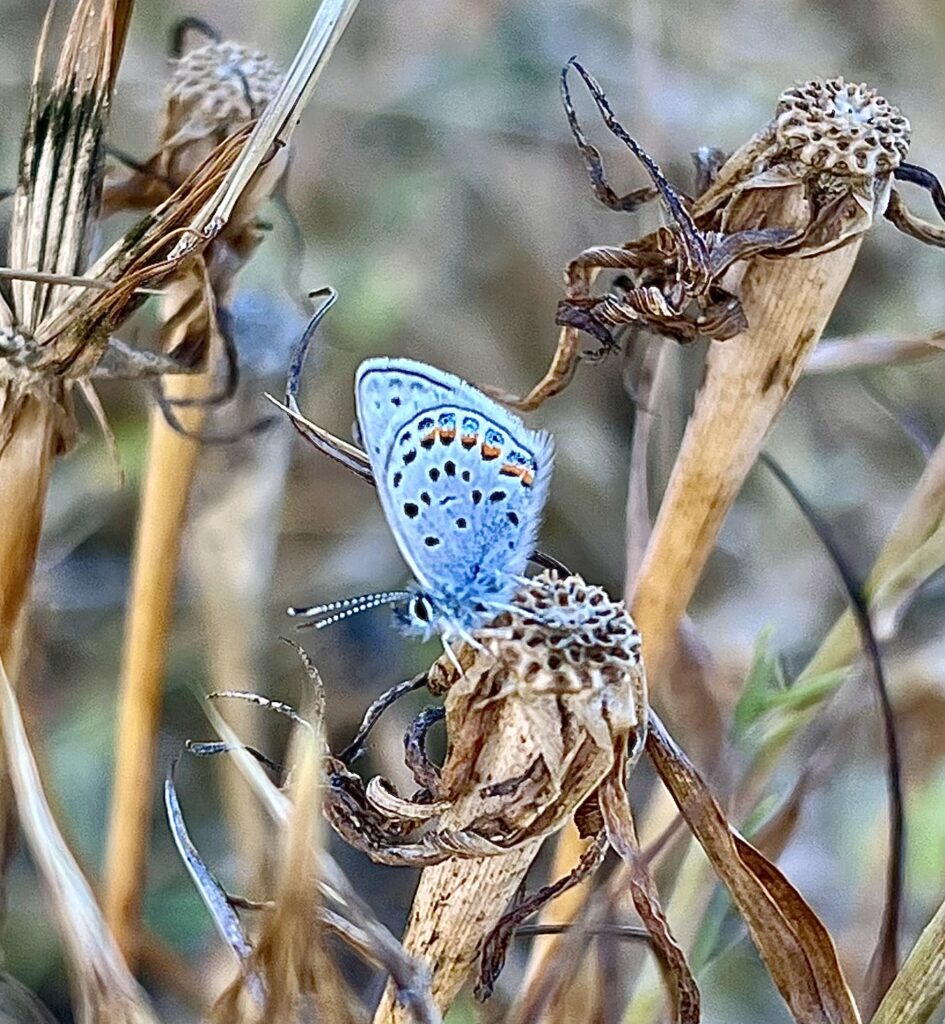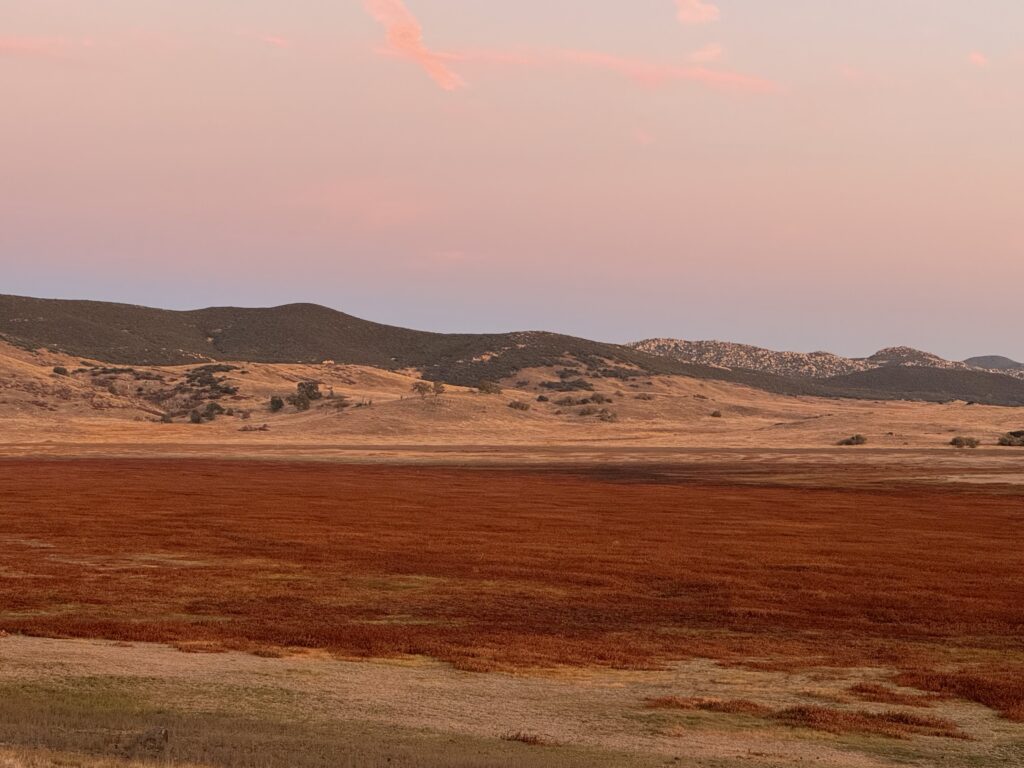
Fall is in the air and the breeze, in the soil and on the calendar. And just in time, as always, comes the perfect precursor for winter, when our natural gardens grow ever quiet. Nights are much cooler, days are shorter and some plants are starting their annual dormancy while others are pushing out new growth… even flowers. Many, of course, have gone to seed. Winter rains are just around the corner.
Current events, history, review, and notes
Anticipation. We’re still asking the southern California question we pose every year – How much rain will we get this year? November is normally the month when storm clouds open the gate for seasonal rains to enter. The other big question is “Where will the gate be located this year?” In some years, most of the rain comes only well north of us. In others, we get a steady stream of weather flowing into our region. Usually, once the gate opens it stays open all season, but it can also shift position.
Said one farmer to the other, “Reckon it’s a-gonna rain?” Reply: Well, if’n it don’t, it’s a-gonna be a helluva long dry spell.”

Watering
Even with our abbreviated day length, the temps can be in the 80’s (even 90’s) and the winds off the land are dry. Keep an eye on soil moisture. Dig a little pilot hole, 4” deep near a few mature plants, basically in their root zone. If the soil is dry to the touch at that 4” depth, you probably should do a Deep Soak (DS). Refreshing Sprinkles (RS) are nice in mid to late afternoon on dry windy days, but doing RS at this time of year is not as critical as in summer.
Not familiar with the terms DS and RS mentioned above? See 2023 July in the Natural Garden, and August as well.
Related to Watering
Keep an eye on weather forecasts. If the garden appears dry, but a good rain is on the horizon, it’s better to delay watering and wait for the rain, unless the plants are brand new and cannot wait. Rain water is better than irrigation water every time, so irrigating in fall and winter becomes a bit of a gamble as you want to get your Deep Soak from the sky.
Pruning
See 2023 October in the Natural Garden for details, but basically, this is still the best time of year to do thinning, heading back, shaping, and every kind of corrective and artful pruning that the plant or the whole garden might require.
Weeding
Nothing new here. Presumably your ground is weed free and freshly renewed with natural or imported top dress in place.
Mulching / Top Dress
See 2023 October in the Natural Garden.
Feeding
November, like October, is a good month for fertilizing your soil and your plants if you’re into that sort of thing. Many natural gardens get by for many years without supplemental feeding, but we have found that treating native plants with a little extra TLC is good for them, and good for you too. Spread a general all purpose dry organic fertilizer and scratch it into the top 1/2” of soil, ideally the day before we are to get a good rain. Watch the results.
Troubleshooting – Varmints, Pests and Diseases
The onset of winter brings a good balance of beneficials to combat injurious plant pests. Root rot diseases are rare when soils are cool. Some folks are noticing certain plants dying or flagging with dead branches. If the plant has leaves blue/gray/silver and the leavers have fuzzy texture, i.e.; some buckwheats, salvias, Eriophyllum, Sphaeralcea, Abutilon, desert lavender… chances are the disease organism is a fungus called downy mildew. You can’t see the actual fungus (that’s powdery mildew you can see), but downy’s devastation happens fast.
It comes around when we have excess humidity in late spring and in fall. As we get into cooler weather it will not be as much a threat. The only practical remedy to salvage a plant which is not a sure goner is to thin the branches so the wind will move through the plant’s top growth to remove excess moisture from humidity and also remove mulch from beneath the plant.
By the way, this disease can hit green-leaved plants too. Buckwheats and sages are quite susceptible. If a plant wilts (all or part) very quickly, and then the branches die, and there is no evidence of a gopher, it might be downy mildew. We see it most frequently on subshrubs and soft branched plants with dense growth low to the ground, but it can attack woody shrubs as well. The storm in August (TS Hilary) may have been a factor this year.
All garden pruning, including corrective pruning on diseased plants should be done with clean tools. You can sanitize your shears with an 8-second dip in a solution of 10% bleach or pure alcohol or by using Lysol spray. Dip or spray the tool between each cut.

Annual Wildflowers
Looking forward to spring? This is the absolute best month for sowing wildflower seeds in the garden. Come on over or shop online. We have several seed blends to choose from. Try to time your sowing around rain. Just before a forecasted storm is perfect.
Adding New Plants
Just like planting seeds, planting new plants in November is ideal. We have a full inventory and a wide selection of natives ready for your natural garden. Come on over.

Phytophilia
Anticipation. Native plants everywhere, natural areas or natural gardens are waiting for rain. But they don’t seem anxious. Nor hopeless. They are patient. By this, can we assume the rains will come? Not necessarily. Native plants are on a different time clock than ours, with greater spans than our seasons or calendar years. So in November they anticipate rain, somewhat expecting it, but taking nothing for granted. As usual, native plants have an attitude we would do well to emulate.
Important Review
Will it rain?
Moist soil, please
Pruning artfully? Yes
Weeding? Check
Mulching. Still Ok
Feeding is good for plants and for you.
Watch for downy mildew
Annual wildflowers absolutely
New plants, November ideal
Anticipation

Engage

Re-wild means approaching your natural garden, its creation and care, and your engagement in it, with mindful purpose. In the process, you encounter nature’s functionality and its aesthetic beauty, while you are experiencing complete healing and wellness; body, mind, soul, and spirit.
Hey, it’s whatever it is. Let’s keep makin’ it!
From the NOVEMBER in the Natural Garden,
Mike Evans
Questions? Help is just one call or one email away. Call (949) 728-0685 or email (with pictures if you like) our special helpline: gardenhelp@californianativeplants.com
All photos by Mike Evans unless otherwise noted.